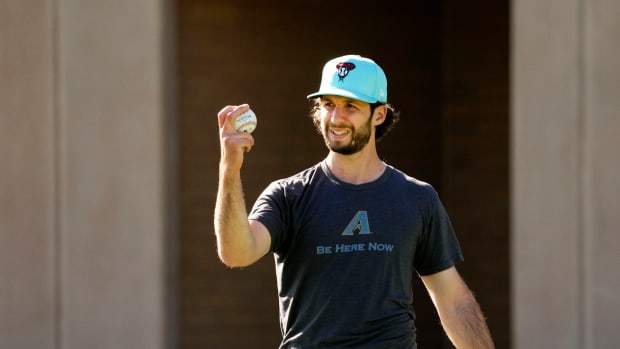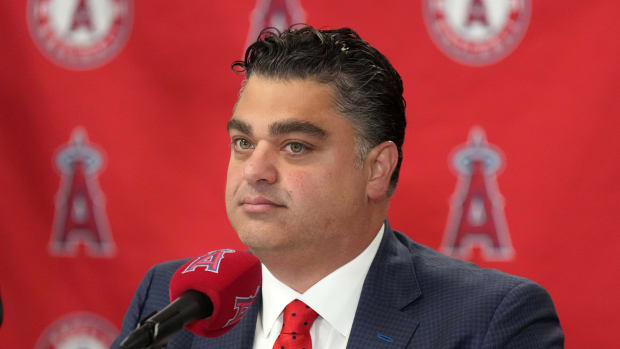Keith Law discusses his new book, "Smart Baseball," and how to get used to sabermetrics
Keith Law, a senior writer at ESPN, has cultivated a following with his unique mix of scouting insights and statistical explanations. His new book, Smart Baseball, out now, takes these ideas further: What’s the matter with RBIs, anyway? How are front offices evaluating players today? And what’s next?
Sports Illustrated: How did this book come about?
Keith Law:I’ve been getting requests from readers to recommend a book like this for a while. It never occurred to me to write this book, but maybe I’m well situated for this. I have a mixed background in baseball and I have experience translating hard concepts into simpler language. I didn’t know what kind of response I would get. A week after the 2015 draft I emailed my agent and said, “I have an idea for a book.” We sold it that fall. The writing started in March of ’16 and the last original content was around December. I kept my job at the same time. I took like one week off at one point to do extra writing. It was quite a year!
SI: Who do you see as your audience?
KL: I tried to write for the maximum number of people. I think of this as a book for a lay audience, for everyone who wants to know more about sabermeterics, who wants to understand how teams are evaluating players. Basically, someone from my parents’ generation who wants to understand, Why are all these stats bad? Why do you always say RBIs are meaningless? I tried to make all these arguments in plain English rather than relying on math. The goal here was to be very inclusive. There’s a lot of anti-intellectualism out there; people don’t want to learn that what they always believed was wrong. But all 30 teams have an analytics department. This is how they’re doing it. It doesn’t matter if you don’t like it. People are entitled to own beliefs but not to their own facts. So far the response has been really positive. If people hate the book, they’re not telling me (or I already have them muted and blocked!).
SI: You have a lot of background yourself, but you clearly didn’t just write this all off the top of your head. What did you learn from researching?
KL: I would say it’s the accumulation of 15 years in the business, but toward the end—the last two chapters—I start quoting people. I spent two-plus hours at MLBAM’s office. They were so kind, talking me through the Statcast stuff. I felt like, I gotta learn all this stuff so I can do the translation. It’s incredibly fun to get access to that. As far as reporting, I tried to cast a wide net. Not everyone wanted to say too much; these are trade secrets, and I don’t blame them. If I felt a person has credibility, I felt comfortable quoting them on an anonymous basis.
MLB Mock Draft 1.0: Should Twins take Brendan McKay or Hunter Greene with No. 1 pick?
SI: You’ve had kind of a backwards career—you started as a stat guy at Baseball Prospectus and as a special assistant with the Blue Jays, then started scouting partway through your time there and now you write about prospects for ESPN. Do you think doing it in that order affected how you saw the game?
KL: Part of me says I wouldn’t change it, but it felt at first like, Am I going backwards here? Scouting’s supposed to be the retrograde aspect of this, but it turned out it wasn’t. Scouting can be progressive in its own way. There are people who play the stereotype, but it’s not that common. Most people are very rigorous in their process, the observation and the evaluation. People view scouting as this nebulous thing, but there is a lot of rigor to the more serious scouts and the best teams today are really integrating both sides and bringing in player development. If I didn’t have both backgrounds I couldn’t have written the book. It would be hard to imagine going other way, because I’m a math guy. It’s hard to think of a life where I end up in scouting first, because being a stats guy felt more true to who I was as a kid, a math-loving baseball fan.
SI: Why did you make the switch?
KL: When I was with the Jays, 2004 was when I realized we weren’t succeeding. We were limiting ourselves to college players who had certain stat profiles and throwing out so much of talent in the draft. I realized other teams were trying to do the same thing and suddenly the pool was incredibly limited. Around the fourth or fifth round, we looked up and said, Everyone we liked is gone. I felt like I needed to get out there and start seeing some of these players for myself. It bothered me that there was a huge aspect of the job that was a black box.
A lot of it is learning what to look for. I was lucky to have people who were willing to do that work with me, and help me get up to speed. You have to see a lot of players. It bothers me when I see people decide, I’m gonna be a scout! I don’t think I started to be good until I saw them as young players and then I saw them either make the big leagues or wash out. I had been at ESPN for four or five years before my high school players made it or didn’t. So then I started to go back to notes and say, All right, what did I think at the time? What did I miss? Looking at my notes is like going back and reading your eighth grade book reports.
SI: Is there anything you wish you’d touched on?
KL: You always wish you had more time. That middle section could have been even longer. I wished I’d been able to answer more questions about, What’s the one number? I try to say a couple of places that there really isn’t one that should be the absolute end of things. Part of me feels like I could’ve given more time to the pitching/defense split. I also wanted to give more direct instruction—If you want to know what a pitcher’s worth, start here—but I also don’t want to be too didactic, talking at the reader rather than making it conversational. Maybe there’ll be another edition!
Paul Goldschmidt is on his way to a potentially historic season
SI: How much of this stuff is going to be obsolete soon?
KL: That’s definitely going to happen. Especially with the Statcast stuff, they haven’t released a whole lot yet.
SI: There’s been a lot of discussion recently about the homogeneity in front offices. It’s not a subject you spend too much time on in the book, but you do mention that you are now underqualified for the job you originally held with Toronto. Do you think teams are thinking about diversity as a market inefficiency?
Some teams are looking for other backgrounds, other industries—the Phillies hired a guy from Google to run analytics—but this is just different backgrounds in terms of work experience. I worry that the industry is pretty white male and this emphasis on stat guys isn’t going to help. I have a young daughter who’s very into science and she occasionally drops, “I’m not good at math.” We tell her, “You’re not allowed to say that!” It’s a vicious cycle—studies have shown that if you give a group of women a test and show them an article saying women are worse at this, they’ll do worse. So we try to reinforce “You can do anything” to try to cancel out what she’s hearing in the world. So I’m pretty passionate about this. I worry about the diversity issue in baseball because that’s pretty narrow labor pool to be drawing from. How many people do you know who pursue a Ph.D. in mathematics and then are willing to go into baseball and make less money than they might elsewhere? I don’t think the diversity problem is getting better. We should know better by now. Well, we know better. We’re not doing better.
SI: Toward the end of the book you get into the question of wearable trackers. It’s no wonder that teams are salivating over the prospect of more data, but do you think there will be pushback from players? And will we see this stuff in games any time soon?
I doubt we’ll be seeing it in games, but I think we’ll see wider adoption. Teams are trying this stuff even if they’re not sure it’s going to work, because why not just try it? Vendors are looking for early-adopter teams and they say, “Just try it for free!” But it’s dangerous. Are we gonna do blood tests on players? What about Rocco Baldelli [the former Ray who was diagnosed late in his career with a rare disorder that made him chronically fatigued and eventually led to his retirement]? What if he’d been in the draft and someone had looked and said, “Oh no, you’re not gonna be able to hold up physically”? It’s probably the right decision for the team, but the player got screwed. Brady Aiken [the No. 1 pick in the 2014 draft, who did not sign with the Astros after they took issue with his physical and dropped their offer] at the time of the draft wasn’t injured; there was just a structural problem. He did end up having Tommy John, but not immediately. As we get information there’s an expectation that players will provide, and maybe they shouldn’t.


































